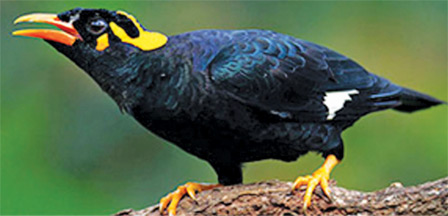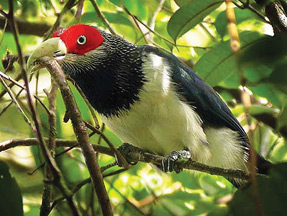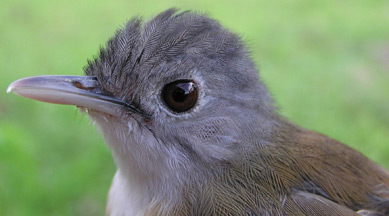Endemic Birds of Sri Lanka
by K.A. Aleem, Gampola Thinakaran Cor.
 Ashy-headed Babbler, Brown-capped Babbler. Red-faced malkoha and Sri
Lanka mynah are identified an endemic birds of our country. Birds are
part of our natural wealth. Ashy-headed Babbler, Brown-capped Babbler. Red-faced malkoha and Sri
Lanka mynah are identified an endemic birds of our country. Birds are
part of our natural wealth.
Ashy-headed Babbler (Garrulax cinerei frons) is a dark brownish-black
bird with the clear greyish forehead and crown black beak and feet. The
birds are confined to natural forests with very little human disturbance
in the wet zone extending upto about 2,500 metres.
It is a shy noisy bird of the ground level moving in flocks of about
4-6 birds. They are seen often on their own or in association with birds
flocks of the wet zone forests, flicking the ground leaf litter in
search of insects. During feeding they call to each other which often
ends up in a loud cacophony. Its food consists exclusively of insects.
Location
There is only a single sighting of its nest at a location close to
Athwalthota near Baduraliya on March 27, 1984.
The nest was similar to that of common Babblers. 3-4 metres above
ground placed in a fork of a free. It had three, sea-blue eggs. It is
believed that the breeding season is between the months of March and
May.
The brown-capped Babbler (pellorneum fuscoca pillum) is a small brown
bird with a darker crown and forehead.
|

Sri Lanka mynah |
The facial area is pale. The colouration varies from a very almost
blackish brown in the wet zone to sandy brown in the dry zone. It is
found at all elevations from the sea level upto about 2,500 metres.
It lives in pairs continuing itself to the flow of low scrub or
forest undergrowth. They are territorial and the male bird advertises
its territory every day in the morning with its characteristic call.
During the breeding season they often sing a melodious song. Its food
consists of insects.
The nesting season is mainly from February to April. The nest is
generally built on the ground often at the foot of a large tree or under
a clump or bush.
The nest is dome shaped, made mostly with two or three leaves where
eggs with blotches of varying colours are laid.
Red-faced Malkoha (phaenicophaeus pyrrhocephalus) is dark blackish
green on top and white below except the breast region which is streaked
dark.
The long tail is tipped white. The facial area is characteristically
red with a greenish beak.
|

Red-faced Malkoha |
The birds are confined to natural tall forests that with low human
interventions. In the dry zone they are presently confined to a few
riverine forests patches. They are common in the wet zone low country
forests upto about 400 metres.
They are found living mainly at the top canopy skulking among the
branches in search of insects, small animals and also fruits.
It flies from one canopy to another or go straight into the middle of
the canopy and work outwards.
It is believed that they nest mostly around April - June. Two to
three chalky coloured eggs often stained with nesting materials are laid
in a cup shaped nest made out of twigs in a fork of a tree.
Breeding
The birds' endemic status has remained a controversy ever since it
was sighted in Kerala in 1959.
This is the only record to date and no breeding has been reported
from India and it is reliably considered as a stray sighting.
Sri Lanka mynah (Gracula ptilogenys) is called Lanka Selalihiniya in
Sinhala.
|

Ashy-headed Babbler |
The metallic glossy black and purple bird with a single pair of
bright yellow lappets on the nape and the orange yellow legs and feet
makes this bird unique.
It is confined to such habitats between 500 - 2,000 metres. The bird
prefers the top canopy of well wooded natural forests.
During the non-breeding season small groups of 4 to 6 birds are a
common sight. Its food consists exclusively of wild fruits and insects.
It is a very vocal bird especially during the breeding season. Its sharp
call can be heard across the valleys in the evenings. The main breeding
season is from March to about May. The nest is in a tree cavity. It lays
two blue eggs speckled with red red-brown to black.
The hill mynah talks well and is a preferred pet by many.
|

